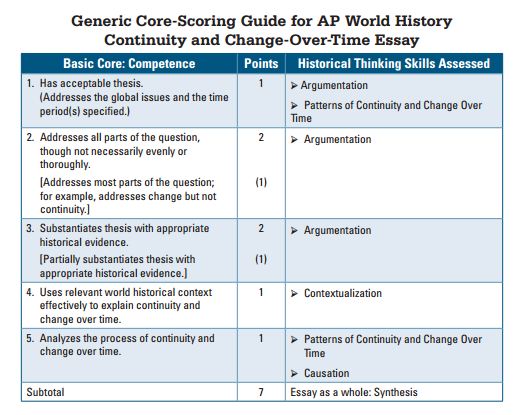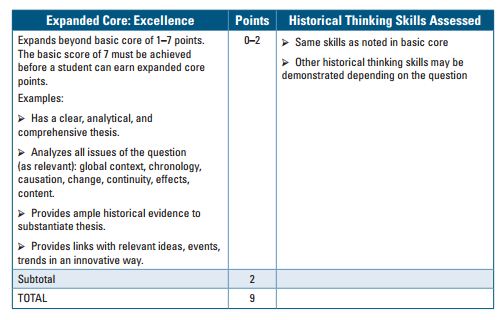|
RESOURCES FOR THE CCOT ESSAY:
|
CONTINUITY AND CHANGE OVER TIME ESSAY
This essay deals specifically with the analysis of continuities and changes over time and covers at least one of the periods in the concept outline. It can address, for example, any of the course themes, such as technology, trade, culture, migrations, or environment. There may be some internal choice within the question, so that you are able to choose to draw your evidence from a case that you know better. The continuity and change-over-time essay questions require you to demonstrate your mastery of historical thinking skills. Moreover, you are expected to construct an argument that responds directly to the question; doing so should cause you to use several of the other historical thinking skills (argumentation, causation, contextualization, and synthesis). The generic scoring guide for the continuity and change-over-time essay is attached below; following that, below on this page is a sample CCOT essay question and three student sample essays (only one of which is a nine). Sample Essay Question:
Analyze continuities and changes in cultural beliefs and practices in ONE of the following regions from 1450 to the present.
What Good Responses Should Include (in reference to CCOT topic above): A good response analyzes continuities and changes in cultural beliefs and practices in one of the stipulated regions (Sub-Saharan Africa or Latin America/Caribbean). "Cultural beliefs and practices" is understood very broadly in wold history to include religion, philosophy, ideology, science and technology, education, the arts, literature, and architecture. Students do not have to address the entire region, but all examples they provide must fall within the stipulated region. Because the central task in this question calls from analysis of continuity and change, acceptable thesis statements need to address both, stating at least one continuity and at least one change. Acceptable thesis statements also need to be explicit, not simply restatements of the question or vague statements such as "there were more changes than continuities." They also need to be relevant to the time period, beginning in roughly 1450 and ending sometime in the post-WWII 20th century. A good response provides analysis of valid continuities and changes in cultural beliefs and practices, supported by specific pieces of evidence from within the time period, which provide supporting examples of continuity or change. For example, in terms of continuities, students could point to the continuation of the practice of indigenous religions in either area and also to the continuation of the spread of Christianity in either area or of the spread of Islam in Africa; the ways in which migrants continued their cultures in new environments; the ways in which culture was used by all types of leaders to support political systems; the ways in which language, religion, and social customs provided a sense of identification. In terms of change, for the 16th and 17th centuries, students could examine the development of syncretic forms of religion such a vodun or the cult of the saints or the way in which the Spanish and Portuguese rulers of Latin America used art and architecture to legitimate their power. For the 18th 19th centuries, they could discuss the spread of Enlightenment thought in Latin America and the consequences of this; the impact of new racial ideologies, such as Social Darwinism, in Africa; the development of millenarian ideas such as the Xhosa Cattle-Killing Movement; the spread of anti-imperial, nationalist, and communist ideology in either area. For the 20th century, students could examine the spread of the idea of human rights; the formation of new cultural identities, such as negritude; the ways religion was applied to political issues, such as fundamentalist movements and Liberation Theology; the increasing globalization of consumer culture. Any of these examples would need to be tied into the process of change and continuity, as would any background information that students provide to set up their essays. A good essay moves beyond a mechanistic "beginning, middle, and end" format and provides solid chronological knowledge across the entire time period. Further, students should think about including dates in their essay to demonstrate that they have the ability to describe with some precision when continuity and change happened. Solid historical analysis explains the reason for or the impact of a specific continuity or practical change, and a good essay provides specific discussion of cause and impact. For example, the statement "Nationalism grew in Africa in the 20th century" is a solid piece of evidence about change, but tying this to a cause or effect would generate this superior analysis, "Nationalism grew in Africa, which led to the overthrow of European empires." An essay that effectively addresses world historical context might describe an extra-regional connection or a global process to explain continuity or change in cultural beliefs or practices. For this essay, students would need to focus on specific global links relative to the question, instead of focusing on a similar situation somewhere else in the world. For example, saying that "China and Brazil both had Jesuit missionaries" is a comparison, not a connection. Arguing that "European Jesuit missionaries were proselytizing in South America and winning converts. This happened in China as well" does, however, draw an extra-regional connection because the term European Jesuits provides a specific reference showing how European practices affected South American beliefs. A strong essay would demonstrate greater nuance and sophistication, including the relationship between change and continuity. It might note, for example, that a change in the early part of the long period covered in this question became a continuity for the rest of the period: The introduction of Christianity was a change in Latin America/the Caribbean, but then Christianity's presence and expansion became a continuity. Similarly, nationalism developed as an ideology beginning in the 18th century, but then became a continuity and has remained so through the present. A specific example of syncretism, such as vodun, could be introduced as a change when it first developed, but the process of the syncretism of different beliefs, ideas, or artistic forms is a continuity across the entire time period. The best essays will be those that do all of this, engaging their own content knowledge with the specific framing of the question. Sample Essay Prompt/Rubric: Write an essay that
| ||||||

